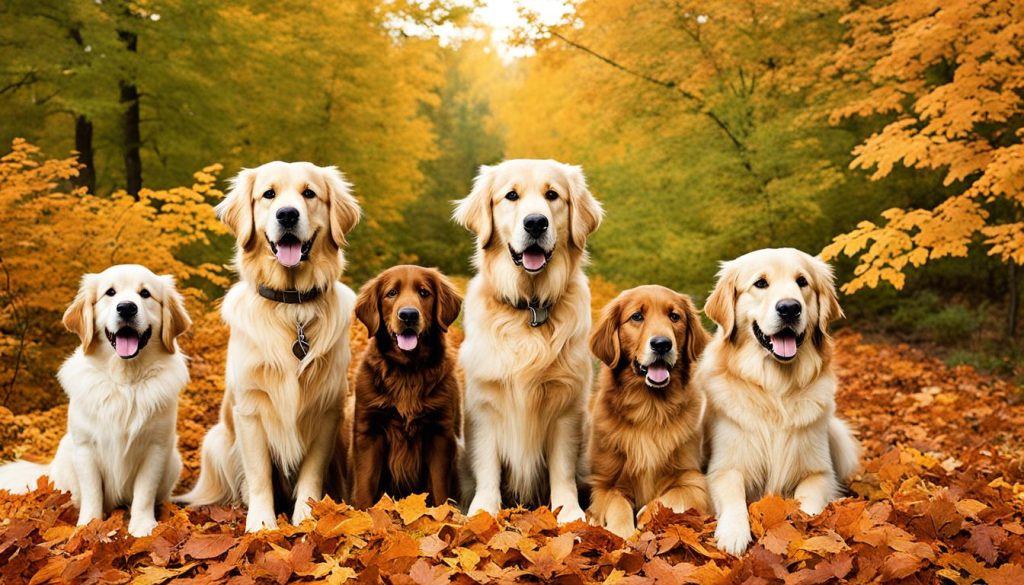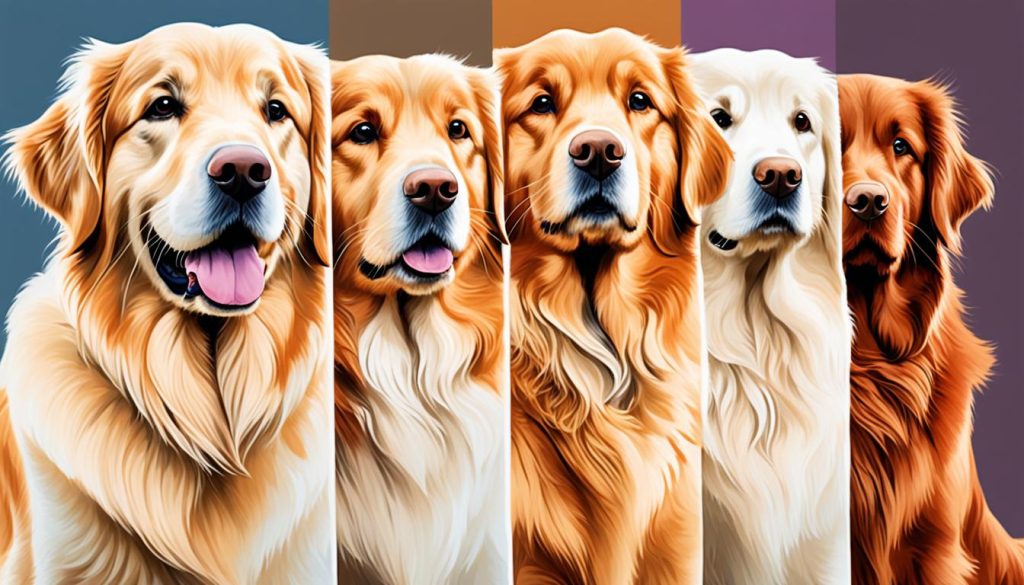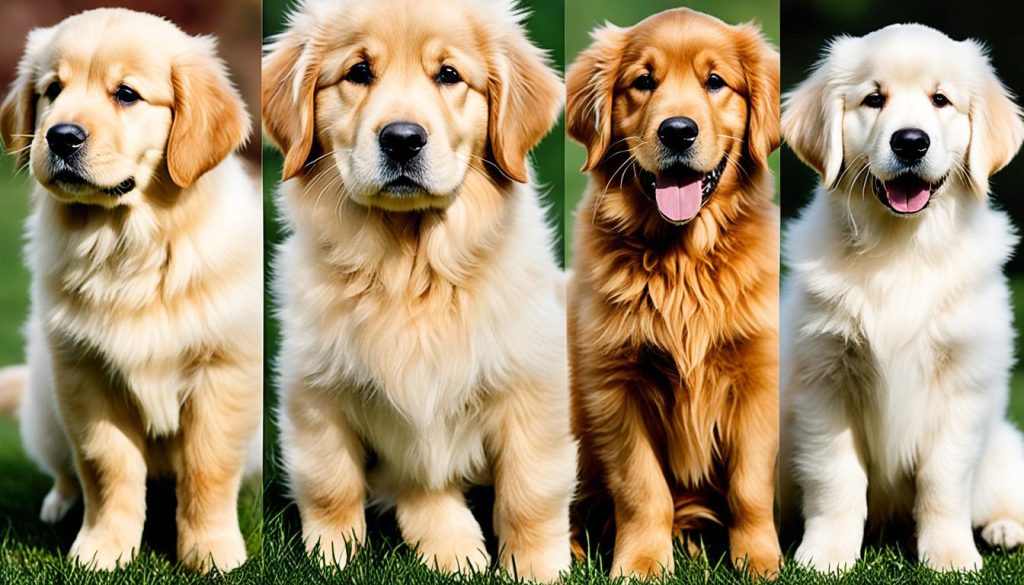Embark on a refined exploration of golden retriever colours. This journey sheds light on the breed’s affectionate nature and appealing presence. Golden retrievers, renowned for their amiable nature and shimmering coats, display a broad spectrum of fur shades and coat shades. These intricacies, embedded within their genetic fabric, captivate observers. They conform to breed standards — an amalgamation of tradition, genetics, and artistic appeal.
Key Takeaways
- Insight into the dazzling array of golden retriever coat colours.
- Understanding of the genetic basis for breed-specific fur shades.
- Appreciation of breed colour patterns in showcasing standards.
- Exploration of the implications of coat shades for canine health and grooming.
- Awareness of the role of coat pigmentation in the breed’s aesthetics.
The Spectrum of Golden Retriever Colours
The golden retriever’s colour spectrum is visually captivating, extending from classic golden to subtle light creams and deep russet golds. This array of colour variations not only enhances the breed’s visual appeal but also strengthens its identity within canine circles. Before we delve into the specifics of these hues, grasping the basis of these colour patterns is crucial.
Exploring the Standard Coat Shades
The breed standard acknowledges a variety of golden retriever colours, each with its own allure. These coat shades are scrutinised by enthusiasts, who inspect the fur tones to admire the breed’s inherent beauty. From rich dark amber to the coveted pale cream, the nuances in retriever fur hues spotlight the breed’s lineage and unique status.

The Significance of Colour in Golden Retriever Shows
In the competitive realm of dog shows, golden retriever colour patterns are meticulously evaluated. Judges assess colour variations against breed standards endorsed by kennel clubs worldwide. These nuances in fur hues influence judges’ decisions, underscoring the importance of aesthetic ideals and breed integrity in the competition arena.
Understanding Colour Variations and Breed Standards
Major canine associations have set forth guidelines for golden retriever colour patterns to safeguard the breed’s integrity. Breeders and dog enthusiasts commit to these standards, which specify acceptable coat shades and their variations. The adherence to recognized breed colour patterns maintains the breed’s historical essence and ensures a future where golden retrievers faithfully exhibit their characteristic hues.
| Coat Colour | Description | Standard Recognition |
|---|---|---|
| Light Golden | A soft, pale shade often compared to cream | Accepted by most Kennel Clubs internationally |
| Golden | The classic, rich colour that is eponymous with the breed | Widely recognised and preferred for shows |
| Dark Golden | A deep, reddish gold offering a regal appearance | Permissible but less common in show rings |
The classifications of golden retriever colours play an essential role in the breed’s heritage and the admiration these dogs command. The depth of these coat shades and the dedication to breed standards continue to enchant dog enthusiasts and secure the golden retriever’s lasting appeal.
Decoding Canine Colour Genetics in Golden Retrievers
The exploration of canine color genetics intrigues many, notably the intricate coat pigmentation in Golden Retrievers. Their fur, luxurious in a range of shades, arises from specific genetic interplays, providing a rich topic for discussion. We seek to clarify the genetics shaping these breed colour patterns.

Coat pigmentation in dogs results mainly from two foundational colours – black and red. Variations in Golden Retriever colours result from diverse genes influencing dilution and colour distribution, determining patterns and solidities in their coats.
The beauty of the Golden Retriever’s coat stems from their DNA’s complexity. The following summary elucidates how these patterns manifest:
- The B locus determines if the coat will be black or brown. Golden Retrievers carry the homozygous recessive allele, which does not affect their reddish-gold appearance.
- The E locus decides the expression of eumelanin (black pigment). Dominant “E” allele allows black pigment, while “ee”, prevalent in Golden Retrievers, results in a red to yellow coat.
- The I locus, or Intensity locus, affects the phaeomelanin (red pigment) vibrancy, leading to a range from deep mahogany to light cream.
Through selective breeding, desired breed colour patterns have been emphasised, revealing a genetic complexity under the Golden Retriever’s shiny exterior. To illustrate these genetic interactions, observe the below table:
| Gene | Role in Coat Colour | Common Golden Retriever Genotype |
|---|---|---|
| B locus | Determines base black or brown pigment | bb (Non-black pigment) |
| E locus | Controls expression of black pigment (eumelanin) | ee (Red/Yellow pigment expressed) |
| I locus | Intensity of red pigment (phaeomelanin) | Varies from light to dark |
Studying canine color genetics offers insight beyond academia. It guides breeding choices, promoting the birth of healthy, well-pigmented puppies. Beyond aesthetics, each colour narrates a part of the Golden Retriever’s genetic lineage.
Influence of Coat Pigmentation on Golden Retriever Health
Golden retrievers are cherished for their diverse coat colouration, enhancing their allure. Yet, coat pigmentation’s role transcends aesthetic appeal, impacting health and grooming. This segment examines how pigmentation, health, and grooming intersect, anchored by insights into canine colour genetics.
Is There a Connection Between Fur Shades and Health?
Researchers probe the complex ties between retriever fur shades and health. They question if fur tones hint at health propensities. While it’s posited that coat colours might hint at health issues, existing veterinary perspectives suggest any correlation is minor. Thus, examining these colour variations is vital for a comprehensive understanding of the breed’s health.
How Coat Colour Affects Golden Retriever Grooming
Diverse grooming needs mirror the variety in golden retriever coat colours. The grooming methods depend on the fur tone, affecting how to maintain a vibrant, healthy coat. Owners of lighter-hued retrievers might find matting and staining more pronounced, requiring frequent grooming. Tailoring grooming to each coat type ensures the breed’s wellbeing.
The Role of Genetics in Coat Health and Pigmentation
Grasping the genetics of canine pigmentation is crucial for coat health comprehension. Coat colour, deeply intertwined with genetics, affects not just the pigmentation but also the texture and quality of the fur. This understanding of colour variations through genetics empowers owners and breeders to optimise coat health care.
The elegance of the golden retriever’s coat, with its colour complexities, paints a detailed portrait of this beloved breed. As canine care advances, the exploration into pigmentation offers valuable insights for enhancing these dogs’ lives.
| Fur Shade | Grooming Needs | Health Considerations |
|---|---|---|
| Light Golden | Regular brushing to prevent matting; careful washing to avoid staining | Monitoring for skin conditions more visible against lighter fur |
| Golden | Weekly brushing; milder grooming products to maintain natural sheen | Examinations for common breed ailments unaffected by coat colour |
| Dark Golden | Attention to undercoat during seasonal shedding | Assessment for hereditary conditions, including hip dysplasia |
Conclusion
In our exploration of golden retriever colours, we’ve deciphered the intricate web of canine color genetics. This journey reveals the spectrum of hues—from deep golds to soft creams—that delineate this breed. Each colour bears witness to the complex genetic underpinnings of coat pigmentation. These variations, far from being simple quirks, encapsulate the heritage and identity of the golden retriever. They highlight its elegance in show rings and its vibrancy in daily life.
The exploration into dog fur tones has illuminated the impact of colour beyond mere aesthetics. It is shown that the genetics bestowing these colours on golden retrievers also affect their health and grooming needs. This knowledge is crucial for enthusiasts and owners, providing them with insights necessary for their pets’ care. Understanding the link between grooming and genetics is key to optimal care.
Ultimately, the diverse beauty of golden retriever colours reflects the breed’s genetic complexity and elegance. As this guide concludes, our aim is that readers gain a deeper appreciation for this visual splendour. Moreover, we hope they understand the importance of coat care linked to genetics. As guardians of these animals, we must prioritize their physical and internal well-being, both intricately influenced by the wonders of canine colour genetics.
FAQ
What are the main coat shades found in golden retrievers?
Golden retrievers display an array of coat shades, from light cream to golden and dark golden. These variations are all recognised within the breed’s standards. They present a dazzling spectrum, spanning from the palest to the most richly hued tones.
How do colour variations affect golden retriever shows?
Colour plays a pivotal role in the evaluation of golden retrievers at dog shows. Judges assess the fit of a dog’s coat colour within the established breed standards. Deviation from these standards could negatively influence a dog’s performance and placement in competitions.
Are there any lesser-known retriever fur hues?
Beyond the recognised spectrum of gold to cream, occasional golden retrievers may show red or mahogany fur hues. Yet, these are not widely accepted by key breed associations for judging in official conformation shows.
What genetic factors influence the coat pigmentation in golden retrievers?
The interaction of genes from both parents intricately determines the coat pigmentation of a golden retriever. This complex genetic inheritance is responsible for the specific colour patterns seen in puppies. Thus, these genetic elements play a crucial role in offspring coat colours.
Is there a connection between a golden retriever’s fur shade and its health?
Evidence regarding a link between fur shade and health in golden retrievers remains scant. Nonetheless, this area is under continuous investigation by scientists. They aim to discern any potential connections through ongoing research on breed health predispositions.
Does coat colour affect the grooming requirements of golden retrievers?
Coat colour does not fundamentally alter grooming needs for golden retrievers. However, different shades may obscure signs of skin conditions or dirt, which could necessitate tailored grooming strategies. Regardless of colour, maintaining a rigorous grooming routine is imperative for all golden retrievers.
Can a golden retriever’s coat colour change over time?
Indeed, a golden retriever’s coat may undergo colour transformations from puppyhood to adulthood. This shift can occur in either direction, lightening or darkening, influenced by fur maturation and genetic factors.
How does understanding canine color genetics benefit golden retriever owners?
Grasping the principles of canine color genetics enriches golden retriever owners’ understanding of their pets’ coat colours. It aids in making educated breeding choices and sheds light on health and grooming needs linked to certain fur shades. Furthermore, this knowledge facilitates more informed discussions with veterinarians and breeders about their dogs’ characteristics and requirements.

